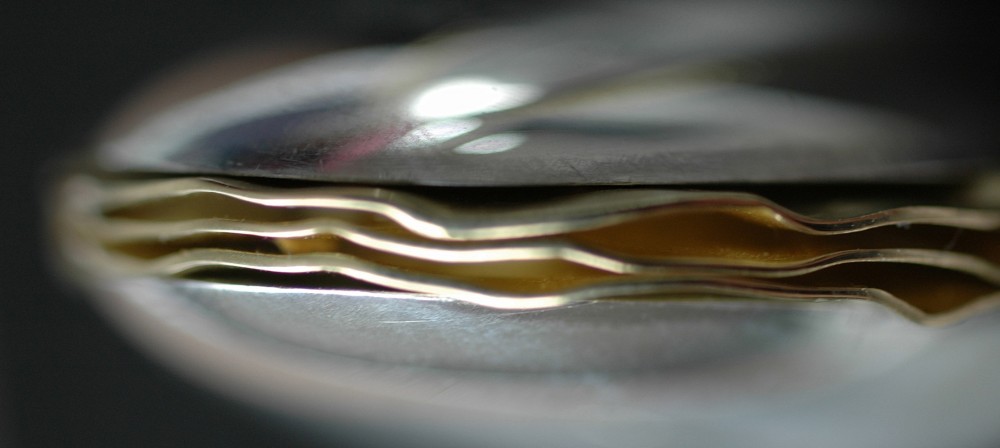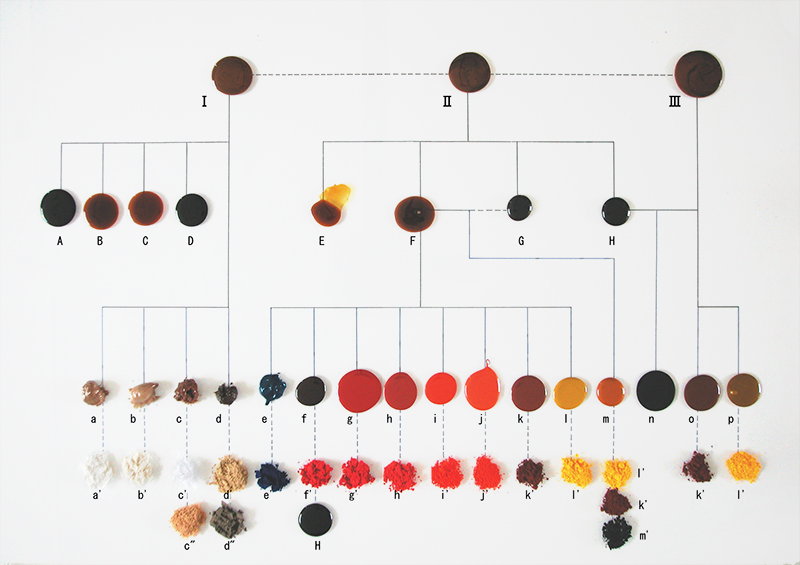JAPANESELACQUERIN ALL ITSASPECTS
Material: What is urushi?
Japanese lacquer (urushi) is the sap of the lacquer tree which grows in some East Asian countries, such as Thailand, Japan, Korea and China. There are many types of lacquer trees and one of the most important groups are the Rhus. This species is found throughout the world and they all have a small or large amount of resin. In Japan, there are still nine species of the Rhus, three of which qualifies for creating the lacquer-material. The Rhus verniciflua undoubtedly provides the best lacquer.
The Rhus verniciflua is a deciduous tree that can reach a height of approximately 20 meter.
Urushi is very durable and very resistant to acid, heat and water.
The processing of the lacquer
Extraction
The resin is extracted by making horizontal V-shaped incisions in the bark of the trunk and large branches. A white, resinous substance oozes out of these incisions. By contact with the air it darkens to a maroon liquid. This liquid is collected by a cylinder-shaped bamboo pot . The sap runs about for a week from the tree . The incisions are regularly cleaned and made open again . On the drained lacquer forms a skin and impurities sink . In order to remove the impurities , the lacquer is filtered through a cloth. Then the lacquer is slowly heated to evaporate all the excessive water. The tree usually does have an age about 15 years before they start to drain . The best period for draining is the summer. The sap ( Arami urushi ) is filtered to ki – urushi (pure urushi) .
Composition
Urushi constists of 10 to 30% water , 61 to 80 % urushiol (hydrocarbyl ), 2 to 3 % laccase and 3 to 6 % gum . After purification the lacquer still undergoes some specific operations, before it can be used for various color lacquers and various decorative techniques. The quality depends on various factors . As well origin, age, season and location of the tree itself influences the composition of the lacquer .
Polymerize
The lacquer does not dry, but hardens by absorbing water molecules ( polymerize ) . Therefor the lacquered pieces are placed in a dust-free space (muro). Ideal conditions for curing is a humidity of 90 % and a 30 ° C. The hardening can take both hours or days .
Subsurface
The lacquer can be applied to all kinds of materials, such as wood, copper, tin, textiles, dried clay, porcelain, leather, gold and silver. In most cases, the substrate is a soft wood species , such as pine , willow , elm , and others.
Procedure
The lacquer must be applied in very thin layers otherwise is doesn’t harden. It is done with a brush calles a Hake. A hake is a brush that is made of human hair over the entire length. Dust is the main enemy. A wet piece is placed in the muro to harden. A muro is a wooden closet that is kept warm and humide. After hardening, each layer is sanded and polished. The color of the paint is obtained mainly by metal oxides, nowadays also synthetic pigments. Vegetal pigments are usually affected by the lacquer. Line drawings are applied with a fine brush called a neji-fude. For powder-sprinkling a bamboo tube with at one end a strainer, a funfutzu, is used.
Different types of lacquer
This is just a brief overview
Urushi: when referring to the sap of Rhus Verniciflua
Nuri: a term meant to denote varnish, but in the sense of a varnished object. As opposite of urushi, juice of lacquer tree.
Ki-urushi: raw unfiltered lacquer
Seshime-urushi: raw lacquer tapped from the branches and of lower quality
Kijomi-urushi: raw lacquer tapped from the trunk. This lacquer is of the highest quality
Nashiji-urushi: a transparent lacquer with a red-yellow tone. This varnish becomes lighter over time and get more shine.
Roiro-urushi: black paint, color obtained by Haguro (iron filings in strong vinegar rice to cook.)
Shu urushi: red lacquer, color obtained by mercury sulphide or cinnabar
Shei-shitsu-Nuri: green paint
Kijiro-urushi: transparent varnish for mixing pigments, mainly red
Benigara-urushi: brown red paint, color obtained by ijeroxide, is used for the preparation.
Suki-urushi: the most transparent varnish, lacquer raw tapped from trees that are over a hundred years old.
And so many more
This urushi-table is a good example to show all the different lacquer.
This images is found on http://www.urushi-kobo.com/urushi.html
Decorative techniques
This is just a brief overview
Kanshitsu: This technique has come over from China to Japan. These objects are created consisting only of fabric and paint. This makes the subject very light and strong. The basic material for objects in drooglak dust (hemp or linen) soaked in lacquer. The soaked cloths are laid in or on a clay mold, which can then be broken up later. After curing, the object is painted back and edited. This technique is used for sculptured figures and utensils.
Keiran / Rankaku / Tamago-ji: inlaid with eggshell. After the thin film on the inner side of shell is removed, the eggshell finger pressed flat on the wet paint. About different layers of lacquer are applied to the level difference is gone.
Raden: mother of pearl inlay. Pearlescent is cut into the desired shapes, and applied in the wet lacquer.
Maki-e (sprinkled picture): because the acid in the resin also oxidizes some metals, one can only use tin, aluminum, silver, gold and platinum.
Hiramaki-e: The drawing in metal powder is slightly off the ground
Kijimaki-e: Drawing in metal powder on unpainted wood
Taka maki-e: Here is the drawing clearly embossed on the surface.
Togidashimaki-e: Drawing metal powder is flush with the surrounding paint and the whole is polished.
Negoro-Nuri: occurs mainly in red-black. First black is apllied and then red. By polishing the surface black will appear again.
And again so many more…

